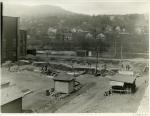CHANGING OF THE HELM – FATHER TO SON

Construction of B Machine at Oxford Paper Company, Rumford, 1915
Greater Rumford Area Historical Society
In 1912, Hugh J Chisholm stepped down as President of Oxford to remain on the board as only a member, while his son, by the same name, would take the helm. His son had attended Yale in the Arts and Harvard Law School and had been brought up in a pulp and paper family. He already had a wide knowledge of the industry. Now, as President of Oxford, he was determined that the company would continue to be one of the foremost producers of fine quality book and specialty papers. He set into motion plans for further expansion in Rumford. He observed a growing demand for high gloss papers. The new Maine Coated Paper Company. was organized in 1913 with six single coating machines. It was to purchase paper in rolls from the Oxford Paper Company, coat both sides, then cut to sheet size, package, and ship to the customer. Expansion was needed, such that 12 coaters were in operation by 1930. This operation became part of the Oxford name in 1922.
The new President of Oxford continued in his father's footsteps, seeing the need for expansion to meet the needs of a rapid growing country. Between 1914 and 1918, three new paper machines were installed, A, B, and C in the south end of the paper mill complex. The No's. 7 and 8 had been used to account for two little used paper machines that had been purchased from International Paper Co. for the production of heavier weights and brown papers. The A,B,C connotation was changed to 7, 8, and 9 in the 1960's after removal of the IP machines.
WW I, the Depression of the 30's, and WW II all developed during Hugh J.'s term as President of Oxford. He vowed to press forward and be in a position to produce in record amounts after the conflicts were over. Many acres of woodlands were purchased and satellite pulping plants were obtained. No. 11 Paper Machine was installed and brought on line in 1924. By 1930, 30 years since its beginning, the Rumford Mill was the country's leading manufacturer of fine quality book and specialty papers, soda pulp, and sulphite pulp. The plant at Rumford was the largest book paper mill in the world under one roof and had a capacity of 350 tons of paper a day.
The Rumford Falls Power Co.'s ability to generate adequate power for the paper manufacture and all the residential homes and businesses in the Rumford Falls area had been stretched to its limit. Major reconstruction, with additional head gates, penstocks, and three new electrical generating turbines were installed 1918. Power now was in abundance such that electrical power was made available for many miles from its point of origin. A survey of the steam power to drive the steam engines of each paper machine, dry the paper, cook the pulp, and heat the buildings found a need for a new and modern steam plant. This plant, authorized in 1930, had room for four boilers, with the first two units going on line in Jan. 1931. All through the Depression, rebuilds of most of the paper machines were completed, as slack demand for book papers allowed for staggered machine outages. The general world Depression and a country business Depression lasted for nine years, coupled with the major flooding of the rivers in 1936, left the Oxford Paper Co. with little profit. This would be running directly into the pre-WW II era.

Bag Mill bachelor housing, Rumford, 1946
Greater Rumford Area Historical Society
These years of war presented a big challenge to all American industries. To the Oxford Paper Company the challenge was: How to keep producing paper needed in the war effort despite frightening shortages of manpower, wood, chemicals, and the supplies normally needed in the operation of its mills? It took careful planning and considerable ingenuity to keep the Oxford mills operating. Manpower became a premium, as able bodied men were either drafted or enlisted in the armed forces. Many women were enlisted to do work in all departments of the mills and keep production rates up for needed war supplies.
Research and development of new grades were always a part of the Oxford Mill's program. It was these achievements that kept Oxford in the forefront of coated papers. In 1946, Oxford's No. 11 Paper Machine was completely rebuilt, modernized, and converted to a coating machine. Plans were also completed in 1946 for the installation of another high speed coated paper machine, the 523 foot long No. 12 machine. Room also was required to house new super calenders. These went into production in 1948.
The supplying of electrical power to the residential neighborhood and businesses needed to come to an end, and the power plant was sold to the Central Maine Power Company, which took over maintenance of the plant and supplied the mill with power. Rumford Falls Power completed an expansion of their power generation capabilities in 1954 by installing two new penstocks from the middle canal to turbine generators located on river bed basin 80 feet below. This expansion was to utilize the full extent of the Great Falls as it was first envisioned some 76 years earlier by the original Hugh J. Chisholm.
Hugh J. Chisholm II was now seventy years old and had served as President of the Oxford Paper for 44 years. These were all trying years, through thick and thin, but Hugh developed the Oxford Paper Company from an organization producing 41,260 tons of paper per year to one producing 270,740 tons. Through his efforts he had kept the Company in the forefront of producers of fine quality book, business, and specialty papers.